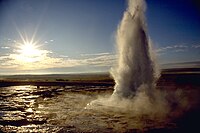
Photo from wikipedia
This study identifies causes of rising arsenic (As) concentrations over 17 years in an inter-montane aquifer system located just north of the Trans-Mexican-Volcanic-Belt in the Mesa central physiographic region that… Click to show full abstract
This study identifies causes of rising arsenic (As) concentrations over 17 years in an inter-montane aquifer system located just north of the Trans-Mexican-Volcanic-Belt in the Mesa central physiographic region that is extensively developed by long-screened production wells. Arsenic concentrations increased by more than 10 µg/L in 14% (3/22) of re-sampled wells. Similarly, in a larger scale analysis wherein As concentrations measured in 137 wells in 2016 were compared to interpolated, baseline concentrations from 246 wells in 1999, As concentrations rose more than 10 µg/L in 30% of wells. Between 1999 and 2016, the percentage of all wells sampled in each basin-wide sampling campaign exceeding the World Health Organization's 10 µg/L drinking water limit increased from 38 to 64%. Principal Components Analysis (PCA), step-wise multiple regression, and Random Forest modeling (RF) revealed that high As concentrations are closely associated with high pH and temperature, and high concentrations of fluoride (F), molybdenum (Mo), lithium (Li), sodium (Na) and silica (Si), but low calcium (Ca) and nitrate (NO3) concentrations. Pumping-induced mixing with hot, geothermally impacted groundwater generates alkaline water through hydrolysis of silicate minerals. The rising pH converts oxyanion sorption sites from positive to negative releasing As (and Mo) to pore waters. The negative correlation between nitrate and As concentrations can be explained by conservative mixing of shallow, young groundwater with geothermally influenced groundwater. Therefore water carrying an anthropogenic contaminant dilutes water carrying geogenic contaminants. This process is enabled by long well screens. Over-exploitation of aquifers in geothermal regions for agriculture can drive As concentrations in water from production wells to toxic levels even as the total dissolved solids remain low.
Journal Title: Water research
Year Published: 2020
Link to full text (if available)
Share on Social Media: Sign Up to like & get
recommendations!